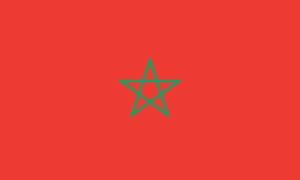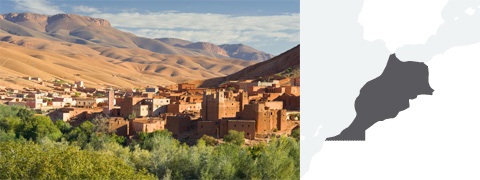Country assessments
Morocco
- Details
- Country assessments
2013 sector transition indicators
Source: EBRD.
Note: Water – Water and wastewater; IAOFS – Insurance and other financial services; PE – Private equity.
Highlights
- High oil prices and a weaker external environment have led to a build-up of fiscal and external pressures. To provide some buffer against external shocks, Morocco obtained a US$ 6.2 billion credit line from the International Monetary Fund (IMF) under a 24-month precautionary liquidity line (PLL).
- The government has faced difficulties in implementing its subsidy reform programme. The authorities have raised fuel and food prices, but further reform measures have been delayed, owing to their politically sensitive nature and strong opposition to them.
- Several steps have been taken to encourage foreign investment. A committee has been set up to ensure a transparent framework for foreign and domestic investment, along with a one-stop shop to offset the impact of bureaucratic hurdles.
Key priorities for 2014
- Large reform gaps need to be addressed in the infrastructure sector. It is necessary to boost the capacity of municipalities to manage their increasing responsibilities for infrastructure and to reform tariffs in order to improve cost recovery. This can be supported by the ongoing efforts towards decentralisation and regionalisation.
- Further reform efforts are needed to boost productivity in the agricultural sector. The lack of adequate infrastructure constrains the development of a competitive processing industry, and improvements are needed in the efficiency of input usage, in particular water and fertilisers, through tariff and subsidy reform.
- Reforms are still required in the power, energy and natural resources sectors. Energy subsidies should be reduced, state-owned monopolies dismantled and transmission systems overhauled, in order to introduce a competitive market for electricity.
Macroeconomic performance
Economic activity has picked up in 2013, after a slow-down in 2012. Output in Morocco expanded by 5.1 per cent year-on-year in the second quarter of 2013 – compared with 2.7 per cent in the same quarter of 2012 – on the back of the continued rebound in the agricultural sector (which accounts for around 13 per cent of GDP and 40 per cent of employment). Growth in non-agricultural production, however, continued to slow, declining to 2.5 per cent in the second quarter of 2013, down from 4.6 per cent a year earlier. In particular, industrial activity remained sluggish, while mining activity was negatively affected by stagnating international prices. Construction continued to contract in the second quarter, dragged down by weak domestic demand and a lack of public investment. Unemployment declined in the second quarter, falling to 8.8 per cent, down from 9.4 per cent in the previous quarter, driven by stronger performance in the agricultural sector. However, youth unemployment remains high, reaching 18.4 per cent in the second quarter.
The external balance continues to be weak. The current account deficit rose to 9.9 per cent of GDP, up from 8.1 per cent in 2011. Morocco’s trade deficit shrank by 5.1 per cent in the period January-July 2013, compared with the same period in the previous year, driven mainly by weaker import growth, stemming from lower oil prices and a decrease in the volume of imported crude oil. Meanwhile, export growth remained sluggish, dragged down mostly by a decline in phosphate exports, owing to falling prices and weaker external demand. After contracting in 2012, tourism has started to show some signs of revival, which could help to ease pressure on the balance of payments should the trend continue. Foreign direct investment flows also improved from January to July 2013, especially large investments in the country’s auto and aerospace sectors.
The fiscal position deteriorated markedly in 2012 and remains under pressure. The fiscal deficit worsened in 2012, reaching 7.6 per cent of GDP, up from 6.7 per cent in 2011. It continued to widen in the first half of 2013, as spending growth outstripped a modest rise in revenue, mostly as a result of increases in wage spending and interest payments.
Risks to the outlook hinge on the ability to implement much-needed reforms. The government has experienced difficulties in implementing its fiscal and economic reform programme. Since the increases in fuel and food prices in 2012, it has become more difficult to implement further subsidy reform. Further deterioration in either or both the fiscal and current account balances could weaken the macroeconomic outlook. In the meantime, the IMF has renewed Morocco’s qualification to access the US$ 6.2 billion PLL following its second review of the country’s economic performance.
Major structural reform developments
The government has faced difficulties in implementing its fiscal and economic reform programme. In their efforts to rein in the fiscal deficit, the authorities have taken steps to reform the expensive universal subsidy system and improve targeting. Food subsidies were reduced by 15 per cent in September 2012, while fuel prices were increased by 20 per cent in June 2012. Since then, however, further subsidy reform has become more difficult, owing to its politically sensitive nature and to increasing opposition. As a result, additional reforms have been repeatedly postponed. In May 2013 Morocco appointed a commission to draw up different proposals for reforming the country’s bankrupt pension system, which has continued to place a heavy burden on state finances. Negotiations are currently underway with various stakeholders. Despite these difficulties, a new fuel price indexation that links gasoline and diesel to global oil prices was introduced by the government in September 2013. Measures have also been taken to limit the effects of higher prices on lower income groups, including safeguards to keep public transportation costs unchanged.
Progress on reforms to the business environment has been mixed. Morocco climbed eight places, to be ranked eighty-seventh (of 189 countries) in the World Bank 2014 Doing Business report. A number of improvements have been made to the business environment. Starting a business in Morocco has become less costly in 2013 compared with previous years, thanks to the reduction in company registration fees. Furthermore, the time required to register a transfer has been reduced and taxing procedures for companies also improved.
The government has taken several commendable steps to encourage foreign investment. Steps have been taken to strengthen the capacity of the National Committee for the Business Environment, in order to help coordinate different ministries, with the aim of ensuring a transparent framework for domestic and foreign investment. The government has also announced plans to make greater use of public-private partnerships, including with foreign firms. To help offset the impact of Morocco’s bureaucratic hurdles, which are constantly cited as impediments to doing business and remain a major deterrent to investors, the government has opened one-stop shop regional investment centres, which are authorised to handle investments of up to US$ 23 million. For larger investments, the government has instituted a package of incentives, such as tax incentives, land grants, simplified administrative procedures, financing instruments and connecting infrastructure. This has helped to attract foreign direct investment in high value-added industries such as automobiles and aeronautics (Renault inaugurated a plant in 2012 and Bombardier began production at its new facility in Morocco in February 2013).
A new mining code has been devised. In July 2013 the government unveiled the country’s new mining strategy, which aims to almost triple revenue from the sector (excluding phosphates) and multiply investments tenfold. A new law has been drafted (and should be voted on at the end of 2013) that aims to attract both foreign and local investors by expanding the geographic coverage granted by individual exploration permits, facilitating the process of renewing the permits and relaxing the categorisation of mining licences.
Morocco has embarked on a series of reforms to deepen the financial sector. A new draft banking law is currently under discussion in parliament and is expected to be voted on later this year. The draft includes provisions to develop the structure for Islamic finance in Morocco, and will cover equities, deposits and Islamic bonds, or sukuk. In March 2013 the Bank Al-Maghrib (the central bank of Morocco) launched negotiations to establish a board of Islamic scholars and financial experts who will rule on the compliance of financial instruments with Islamic law. If passed, this will help to foster the development of alternative financial products and increase access to finance. To this end, the authorities have taken measures to extend micro credit activities, improve financial literacy, and strengthen financial transparency and risk management tools, in cooperation with the General Confederation of Moroccan Enterprises. Reviews of the statute of the Bank Al-Maghrib and the Banking Act are ongoing, with technical assistance from the IMF to strengthen macro-prudential supervision and better monitor systemic risks to the financial sector.
New regulations governing capital markets have been adopted. Under recent changes in regulation, some of the primary market regulators – the Conseil Deontologique des Valeurs Mobilieres (CDVM), the Bank Al-Maghrib and the Ministry of Finance – will increase their independence and supervisory powers. Other recent changes to regulation cover the trading of derivatives as well as covered bonds, which will be issued by banks only and must be authorised beforehand by the central bank. In January 2013 the proposal to amend the existing securitisation framework was adopted by the house of representatives. This amendment includes extending the scope of assets and eligible issuers (to include the issue of sukuk). The government has also made efforts to encourage stock market activity, particularly by small and medium-sized enterprises, by broadening tax incentives for listings on the stock market, including extending corporate tax breaks for an additional three years. Lastly, a draft law that criminalises the funding of terrorism was adopted by Morocco’s parliamentary Justice Committee on 26 February 2013, bringing the country a step closer to conforming to international law.













